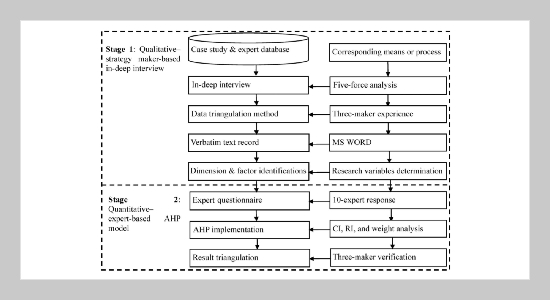REFERENCES
- [1] Zhao, S., Chen, H., Zhao, R., Zhao, Y. and Chen, G., “A Big Data Processing-oriented Prediction Method of Cloud Computing Service Request,” Journal of Applied Science and Engineering, Vol. 19, No. 4, pp. 497–504 (2016). doi: 10.6180/jase.2016.19.4.13
- [2] Liu, Y., Wang, Q. and Chen, H. Q., “Research on IT Architecture of Heterogeneous Big Data,” Journal of Applied Science and Engineering, Vol. 18, No. 2, pp.135–142 (2015). doi: 10.6180/jase.2015.18.2.05
- [3] Lebedev, S., Peng, M. W., Xie, E. and Stevens, C. E., “Mergers and Acquisitions In and Out of Emerging Economies,” Journal of World Business, Vol. 50, No. 4,pp.651–662(2015).doi:10.1016/j.jwb.2014.09.003
- [4] Jhonson, M. W., Christensen, C. M. and Kagermann, H.,“Reinventing Your Business Model,” Harvard Business Review, Vol. 86, No. 12, pp. 50–59 (2008).
- [5] Grünig, R., Business Strategy Development Process, Springer, Berlin, Heidelberg (2008).
- [6] Hagens, M., Onwuteaka-Philipsen, B. D. and Pasman, H. R. W., “Trajectories to Seeking Demedicalised Assistance in Suicide: a Qualitative In-depth Interview Study,” Journal of Medical Ethics, Vol. 43, No. 8, pp. 543–548 (2016). doi: 10.1136/medethics-2016-103660
- [7] Zyoud, S. H. and Fuchs-Hanusch, D., “A Bibliometric-based Survey on AHP and TOPSIS Techniques,” Expert Systems with Applications, Vol. 78, pp. 158– 181 (2017). doi: https://doi.org/10.1016/j.eswa.2017. 02.016
- [8] Porter,M.E.,“TheFiveCompetitiveForcesThatShape Strategy,” Harvard Business Review, Vol. 86, No. 1, pp. 78–93 (2008).
- [9] Deng, P. and Yang, M., “Cross-border Mergers and Acquisitions by Emerging Market Firms: a Comparative Investigation,” International Business Review, Vol. 24, No. 1, pp. 157–172 (2015). doi: 10.1016/j.ibusrev. 2014.07.005
- [10] Rao-Nicholson, R., Salaber, J. and Cao, T. H., “Longterm Performance of Mergers and Acquisitions in ASEAN Countries,” Research in International Business and Finance, Vol. 36, pp. 373–387 (2016). doi: 10.1016/j.ribaf.2015.09.024
- [11] Guggenheim, D., “The Collision of Indeterminate Environments and Porter’s Forces: Uncertainty Fields and Their Impact on Entrepreneurial Alertness,” Strategic Change: Briefings in Entrepreneurial Finance, Vol. 25, No. 3, pp. 239–257 (2016). doi: 10.1002/jsc.2058
- [12] Brandenburger, A. and Nalebuff, B., Co-opetition, 1st ed. Doubleday, New York (1998).
- [13] Dworkin, S. L., “Sample Size Policy for Qualitative Studies Using In-depth Interviews,” Archives of Sexual Behavior, Vol. 41, No. 6, pp. 1319–1320 (2012). doi: 10.1007/s10508-012-0016-6
- [14] Fryer, C., Mackintosh, S., Stanley, M. and Crichton, J.,“Qualitative Studies Using In-depth Interviews with Older People from Multiple Language Groups: Methodological Systematic Review,” Journal of Advanced Nursing, Vol. 68, No. 1, pp. 22–35 (2012). doi: 10. 1111/j.1365-2648.2011.05719.x
- [15] Saaty, T., The Analytic Hierarchy Process, New York: McGraw-Hill (1971).
- [16] Saaty, T., Decision Making for Leaders, 1st ed. Pittsburgh, PA: University of Pittsburgh (2012).
- [17] Chen, K. L., Huang, S. H. and Liu, S. Y., “Devising a Framework for Energy Education in Taiwan Using the Analytic Hierarchy Process,” Energy Policy, Vol. 55, pp. 396–403 (2013). doi: 10.1016/j.enpol.2012.12.025
- [18] Tramarico, C. L., Mizuno, D., Salomon, V. A. P. and Marins, F. A. S., “Analytic Hierarchy Process and Supply Chain Management: a Bibliometric Study,” Procedia Computer Science, Vol. 55, pp. 441–450 (2015). doi: 10.1016/j.procs.2015.07.005
- [19] Choudhury, S. and Saha, A. K., “Prediction of Operation Efficiency of Water TreatmentPlant with the Help of Multi-criteria Decision-making,” Water Conservation Science and Engineering, pp. 1–12 (2017). doi: 10.1007/s41101-017-0034-2
- [20] Schmidt, K., Aumann, I., Hollander, I., Damm, K. and von der Schulenburg, J. M. G., “Applying the Analytic Hierarchy Process in Healthcare Research: a Systematic Literature Review and Evaluation of Reporting,” BMC Medical Informatics and Decision Making, Vol. 15, No. 112, pp. 1–27 (2015).
- [21] Lee, H. S., “Priority Analysis of Subscription Attributes for High-speed Internet Service,” Journal of Internet Banking and Commerce, Vol. 22, No. 1, pp. 1– 18 (2017).
- [22] Denzin, N. K., Sociological Methods, New York: McGraw-Hill (1978).
- [23] Patton, M. Q., “Enhancing the Quality and Credibility of Qualitative Analysis,” HSR: Health Services Research, Vol. 34, No. 5, Part II, pp. 1189–1208 (1999).
- [24] Porter, M., Competitive Advantage, 1st ed. New York: Free Press (1985).
- [25] Chen, Y. S., Lin, C. K., Lin, C. Y., Chuang, H. M. and Wang, L. C., “Electronic Commerce Marketing-based Social Networks in Evaluating Competitive Advantages Using SORM,” International Journal of Social and Humanistic Computing, Vol. 2, No. 3/4, pp. 261– 277 (2017). doi: 10.1504/IJSHC.2017.10005739
- [26] Stock, R. M. and Zacharias, N. A.,“Two Sides of the Same Coin: How Do Different Dimensions of Product Program Innovativeness Affect Customer Loyalty?” Journal of Product Innovation Management, Vol. 30, No. 3, pp. 516–532 (2013).
- [27] Lopes, F. P., Santos, A. P. L. and Santos Filho, M. L., “Indicators to Assess Social Sustainability Aspects— Research in Industries of the Electrical and Electronic Sector in Brazil,” Proceedings of the 2015 IEEE Conference on Control Applications, pp. 583–588 (2015). doi: 10.1109/CCA.2015.7320692
- [28] Cheng, C. H. and Wei, L. Y., “Rough Classifier Based on Region Growth Algorithm for Identifying Liver CT Image,” Journal of Applied Science and Engineering, Vol. 19, No. 1, pp. 65–74 (2016). doi: 10.6180/jase. 2016.19.1.08
















